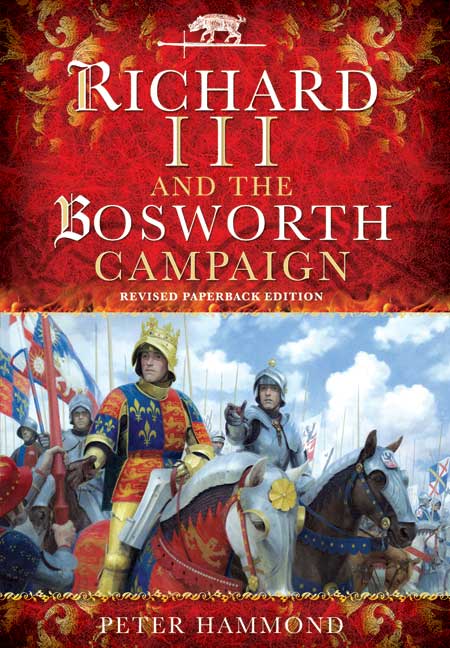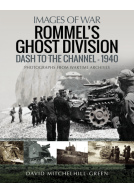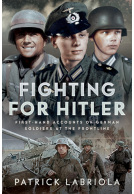Richard the III and the Bosworth Campaign (Paperback)
Revised Edition
Imprint: Pen & Sword Military
Pages: 224
ISBN: 9781783376162
Published: 27th November 2013
(click here for international delivery rates)
Order within the next 4 hours, 52 minutes to get your order processed the next working day!
Need a currency converter? Check XE.com for live rates
| Other formats available | Price |
|---|---|
| Richard the III and the Bosworth… eBook (5.0 MB) Add to Basket | £6.99 |
On 22 August 1485 the forces of the Yorkist king Richard III and his Lancastrian opponent Henry Tudor clashed at Bosworth Field in Leicestershire in one of the decisive battles of English history. Richard was defeated and killed. Henry took the crown as Henry VII, established the Tudor dynasty and set English history on a new course. For the last 500 years this, the most famous battle of the Wars of the Roses, has excited passionate interest and continuing controversy.
Peter Hammond, in a vivid and perceptive account of the battle, retells the story of the tangled dynastic and personal rivalries that provoked the conflict, describes the preparations of the two converging armies and offers a gripping analysis of the contest itself. The latest historical evidence is assessed, including the recent discovery of Richard III's body in Leicester and the fascinating archaeological work that has been carried out on the battlefield.
This lucid, authoritative and readable new history will be essential reading for anyone who is intrigued by the short, unhappy reign of Richard III and the trial of strength that destroyed him.
Hammond’s book on Richard III and the Battle of Bosworth is a fascinating and detailed recount of one of the most significant battles in England’s history. Once I started reading I was hooked and thoroughly enjoyed every chapter... Hammond’s book is a fascinating read that provides a great deal of information with beautiful, relevant images included. Highly recommended!
Sarah Bryson, Author
Read the full review here
A valuables source for people wishing to learn more about this fascinating time. Moreover, as ever with Peter Hammond's books, there is a delicious amount of detail that helps to fill in anyone's knowledge gaps.
Medieval Warfare Magazine
A valuables source for people wishing to learn more about this fascinating time. Moreover, as ever with Peter Hammond's books, there is a delicious amount of detail that helps to fill in anyone's knowledge gaps.
Medieval Warfare Magazine
The greatest merits of this book are its efforts to draw all previous discussions together, rather summarily but in a manageable and sensible way, and at the same time introducing the latest archaeological evidence as well as giving due place to sources such as Jean Molinet - who certainly does need further study and will no doubt receive it.
The Ricardian
Peter Hammond is a veteran researcher and writer about the Wars of the Roses and Richard III, and this excellent and timely work is a welcome addition.
Peter Burley
This is the first book to revisit the battle now that we know exactly where it was fought. Hammond makes not just the most of this new evidence, but goes on to take it in more interesting directions than might be expected. From the archaeology of the missile weapons used he can reconstruct Henry Tudor's armaments and fire power. By combining the records of the battle at the time with an exact knowledge now of the topography, he goes on to suggest why Henry Tudor may have been able to win such an unexpected victory. He speculates that it was Henry's French pikemen, making their first appearance on a British battlefield, who may have taken the edge of the Yorkist attack. I found this a particularly interesting concept and nicely developed here.
The book does not, though, parachute the reader straight onto the battlefield with no preparation. It is a study of the reign as a whole, and satisfyingly contextualises the battle. There is a valuable exploration of the strategic background. Richard's experience in 1483-5 was replicated several times in the War of the Roses - from the Lancastrian preparations for a Yorkist invasion in 1460 through to Henry VII's preparations to defeat Lambert Simnal in 1487. Hammond also takes us on into the aftermath of the battle and the founding days of the Tudor dynasty based on victory in battle.
No book on this period can ignore the Princes in the Tower. He does not plunge uncritically into this debate, but presents evidence and leaves the reader to decide for themselves if so many people would willingly have followed a child murderer. Hammond's Richard is a more rounded and nuanced character than Shakespeare's.
The book also provides a discussion of many of the (sometimes supposed) relics of the battle and of the folklore surrounding it. From my own researches on the Battles of St Albans, I appreciated that folk lore may not be strong on the detail of military deployments, but it may help a lot with background information and perceptions.
This is a well researched, referenced and illustrated work, and its slightly unexpected result, for me, was a greater appreciation of Henry Tudor's achievement in winning this decisive battle.
On 22 August 1485 the forces of the Yorkist King Richard III and his Lancastrian opponent Henry Tudor, Earl of Richmond clashed at Bosworth Field in Leicestershire in one of the decisive battles of English history.
Spartacus Review
Richard was defeated and killed. Henry took the crown as Henry VII, established the Tudor dynasty and set English history on a new course. For the last 500 years this, the most famous battle fo the Wars of the Roses, has excited passionate interest and continuing controversy.
Peter Hammond, in a vivid and perceptive account of the battle, retells the story of the tangled dynastic and personal rivalries that provoked the conflict, describes the preparations of the two converging armies and offers a gripping analysis of the context itself. The latest documentary and archeological evidence is considered, and the author weighs up the merits of conflicting interpretations of the battle and the battlefield. He also pays of conflicting interpretations of the battle and the battlefield. He also pays particular attention to the contrasting characters of Richard III and Henry Tudor, the villain and the victor of the drama, who are reconsidered as individuals and as commanders. This lucid, authoritative and readable new history will be essential reading for anyone who is intrigued by the short, unhappy reign of Richard III and the trial of strength that destroyed him.
We all know respected historian Peter Hammond as the President of the Richard III Society and most of us will have read his previous works on the period. So when this one was published I had to order it immediately.
Richard III Society of New South Wales
In this new book Peter concentrates on the military aspect of the period as a lead up to the Battle of Bosworth and then the battle itself. Peter shows the preparations for the coming conflict on both sides, Richard III and the English government on the one side and Henry Tudor and his rebels on the other, and assesses the military experience of both sides. He then looks at the battle itself and outlines the probably strategies both sids used, based on the available sources. It is a great advantage that this is the first book to be published after finding the exact location of the Battle of Bosworth, I believe, and Peter uses these new findings fully.
Even to a general reader like me, his analysis is highly readable and explains the rather complicated military divide in a way that can be understood by someone who is not an expert in this field.
The book contains four Appendices with interesting background information. Here Peter evaluates the sources for the battle, explains the system of Commissions of Array, assesses the Act of Attainder against Richard and his supporters and also looks at the legends that surround this famous battle, and what truth there might be in the,
Highly reccomended to anyone interested in the period, irrespective of whether you are a Ricardian or Tudor supporter.















